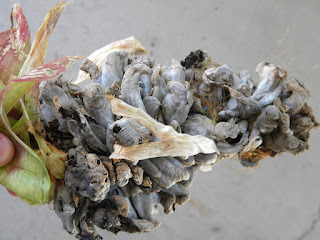Brian brought home this specimen one day last week. It was supposed to be an ear of corn.
The ear is totally infested by common smut. Common smut is a fungal disease that attacks plants in the grass family and flourishes under a variety of conditions. The disease overwinters in the soil and on plant trash. The overwintering stage is known as a teliospore and can survive for several years, so there is always a ready supply of inoculum. It will infect a plant through wounds or holes in the plant's physical structure. In this case the smut attacked the plant through the silk channels, which provide openings into the plant. Normally, pollen grains germinate and grow down the silk channel. Droughts often delay pollen production and the silks will remain viable for several days. In this case the fungus grew down the silk channel first and blocked out the pollen. The fungus is NOT toxic to livestock. In fact the early growth stages of the fungus are edible.
The reason this field is affected is due to timing of fungal spore production and drought stress. The ability of a hybrid to withstand drought stress at pollination can be a factor, but hybrid susceptibility differences are small.

No comments:
Post a Comment